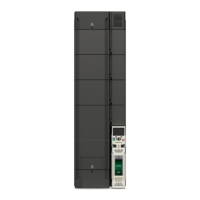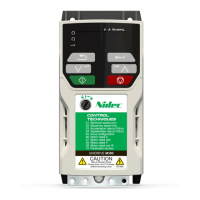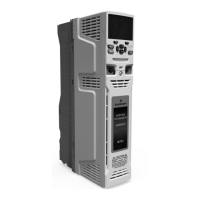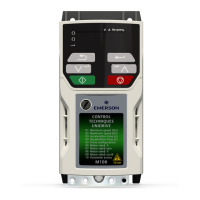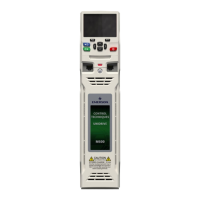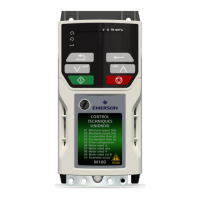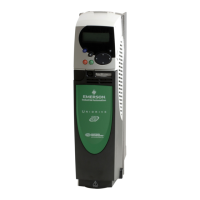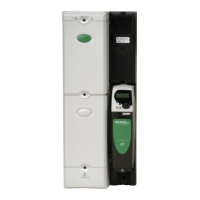Parameter 14.001 PID1 Output
Short description Displays the output for PID1
Mode Open‑loop
Minimum -100.00 Maximum 100.00
Default Units %
Type 16 Bit Volatile Update Rate 4ms write
Display Format Standard Decimal Places 2
Coding RO, ND, NC, PT
Controller
The controller section for the PID controller is shown in the introduction. If the enable is active the PID controller is active even if the destination is not routed to a valid parameter or set
to 0.000. It should be noted that if either of the enable sources is routed to 0.000 or to a non-valid parameter the source value is taken as 1, therefore with default settings,
PID1EnableSource1 (14.009) = 0.000 and PID1EnableSource2 (14.027) = 0.000, the PID controller can be enabled by simply setting PID1Enable (14.008).
PID1Error (14.022) is the difference between the reference and feedback produced by the reference and feedback systems described in PID1ReferenceSource (14.003)
and PID1FeedbackSource (14.004). The PID controller output is defined as follows:
PID1Output (14.001) = PID1Error (14.022) x [Kp + Ki/s + sKd/(0.064s + 1)]
Kp = PID1ProportionalGain (14.010)
Ki = PID1IntegralGain (14.011)
Kd = PID1DifferentialGain (14.012)
Therefore:
1. If PID1Error (14.022) = 100.00% the proportional term gives a value of 100.00% if PID1ProportionalGain (14.010) = 1.000.
2. If PID1Error (14.022) = 100.00% the integral term gives a value that increases linearly by 100.00% per second if PID1IntegralGain (14.011) = 1.000.
3. If PID1Error (14.022) increases linearly by 100.00% per second the differential term gives a value of 100.00% if PID1DifferentialGain (14.012) = 1.000. (A filter with a time
constant of 64ms is provided on the differential term to reduce the noise produced by this term).
The output may be limited to a range that is less than the maximum range of PID1Output (14.001) using PID1OutputUpperLimit (14.013) and PID1OutputLowerLimit (14.014). If
PID1OutputLowerLimit (14.014) > PID1OutputUpperLimit (14.013) then the output is held at the value defined by PID1OutputUpperLimit (14.013). If
PID1SymmetricalLimitEnable (14.018) = 1 then the lower limit = -(PID1OutputUpperLimit (14.013)). If the output reaches either of these limits the integral term accumulator is frozen
until the output moves away from the limit to prevent integral wind-up. The integral hold function can also be enabled by the user by setting PID1IntegralHold (14.017) = 1.
PID1OutputScaling (14.015) can be used to scale the output, which is limited to a range from -100.00% to 100.00% after this function. The output is then added to PID1Feed-
forwardReference (14.019) and is again limited to the range from -100.00% to 100.00% before being routed to the destination defined by PID1Destination (14.016).
Parameter 14.002 PID1 Feed-forward Reference Source
Short description Defines the input source for the feed-forwards reference source for PID1
Mode Open‑loop
Minimum 0.000 Maximum 30.999
Default 0.000 Units
Type 16 Bit User Save Update Rate Drive reset read
Display Format Standard Decimal Places 3
Coding RW, PT, BU
See PID1Output (14.001) and UserPIDController (14).
Parameter 14.003 PID1 Reference Source
Short description Defines the input source for the reference for PID1
Mode Open‑loop
Minimum 0.000 Maximum 30.999
Default 0.000 Units
Type 16 Bit User Save Update Rate Drive reset read
Display Format Standard Decimal Places 3
Coding RW, PT, BU
The reference section for the PID controller is shown in the introduction. The reference section is always active even if the PID controller itself is disabled or the reference source is not
routed to a valid parameter. If a reference source is not a valid parameter or is 0.000 then the value is taken as zero.
The reference is multiplied by PID1ReferenceScaling (14.023) and then limited to +/-100.00%. The reference can then be inverted if required (PID1ReferenceInvert (14.005) = 1) and
then a slew rate limit is applied with PID1ReferenceSlewRate (14.007). This limits the maximum rate of change so that a change from 0.00 to 100.00% takes the time given in
PID1ReferenceSlewRate (14.007).
Parameter 14.004 PID1 Feedback Source
Short description Defines the input source for the feedback for PID1
Mode Open‑loop
Minimum 0.000 Maximum 30.999
Default 0.000 Units
Type 16 Bit User Save Update Rate Drive reset read
Display Format Standard Decimal Places 3
Coding RW, PT, BU
The feedback section for the PID controller is shown in the introduction. The feedback section is always active even if the PID controller itself is disabled or the feedback source is not
routed to a valid parameter. If a reference source is not a valid parameter or is 0.000 then the value is taken as zero.
The feedback is the sum of the feedback source and the PID1DigitalFeedback (14.026). The result is multiplied by PID1FeedbackScaling (14.024) and then limited to +/-100.00%.
The feedback can be inverted if required (PID1FeedbackInvert (14.006) = 1).
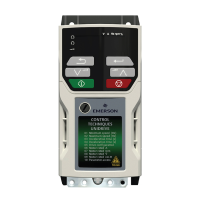
